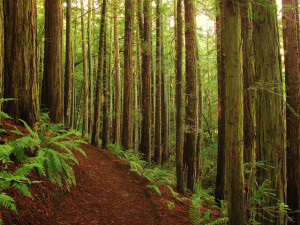The classic image of a redwood forest is one of stately tall trees, dense shade, and lots of green. The columnar trunks of the giant trees draw our gaze up to the high canopy, but if we follow them down to the forest floor instead, in summer months we may find unexpected points of brilliant color. These are the colorful fruits (mostly berries) of the smaller plants that live in the shelter of the big trees. For the birds and small mammals that feed in the redwood forest, the bright colors of these berries are beacons announcing their ripeness in the shady groves. And for the plants, the berry-eating animals are vehicles for dispersing their seed to colonize new locations. Although consumed by wild animals, most of these fruits— with the notable exceptions of thimbleberry and huckleberry— are either unpalatable or outright toxic to humans. (And note that collecting is prohibited in many parks.)
Some of the berries on these pages are found in the shadiest depths of the forest, while others grow and thrive where more light penetrates: along creeks, in openings created by fallen trees, and near forest edges where light and plant diversity increase. Though not abundant, these lovely fruits are worth watching for when you’re enjoying our local redwood groves in the summer months.

.jpg)

-300x203.jpg)
-300x201.jpg)